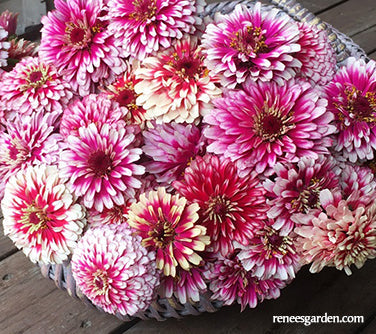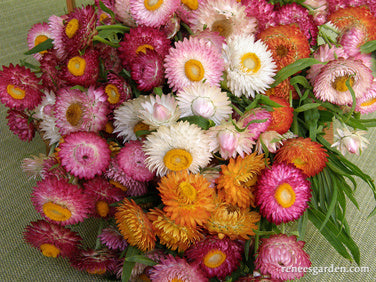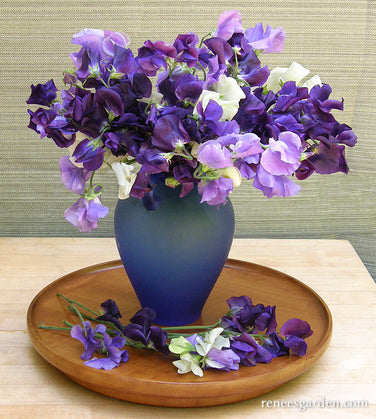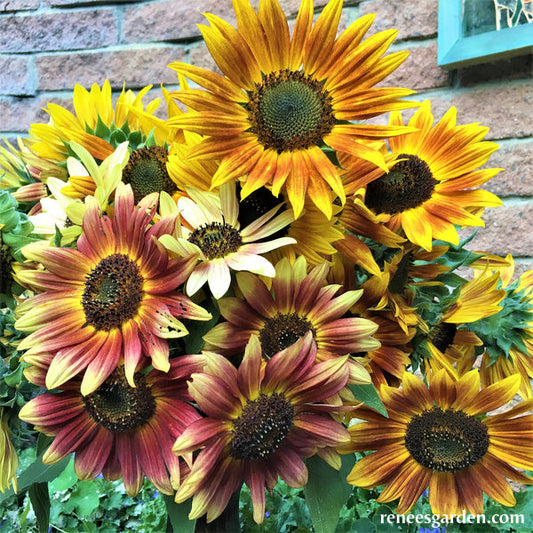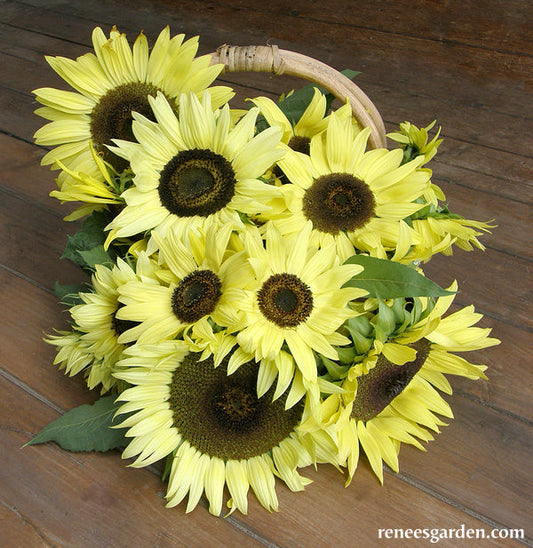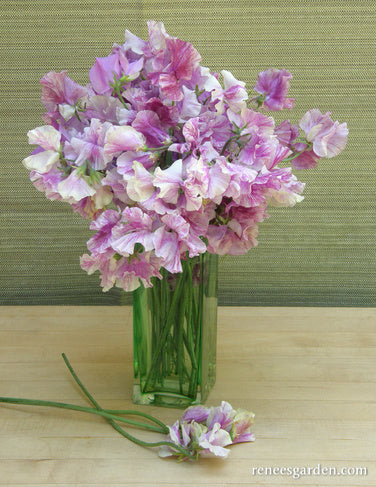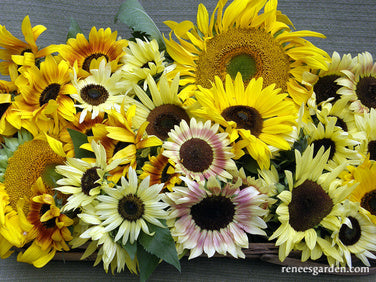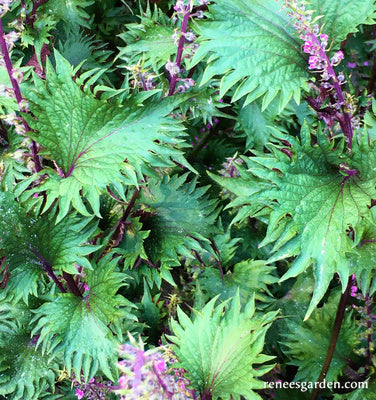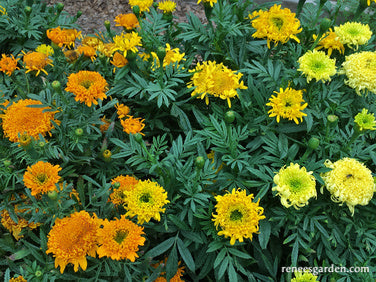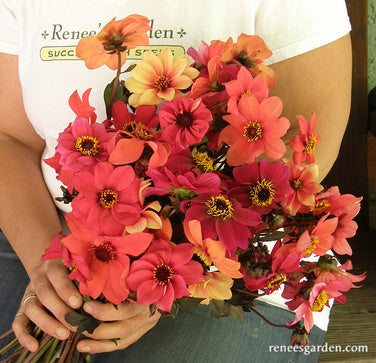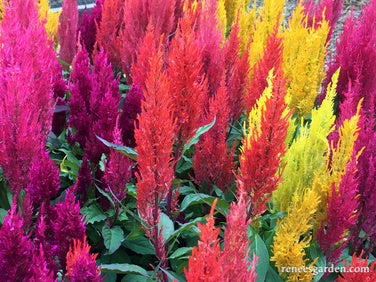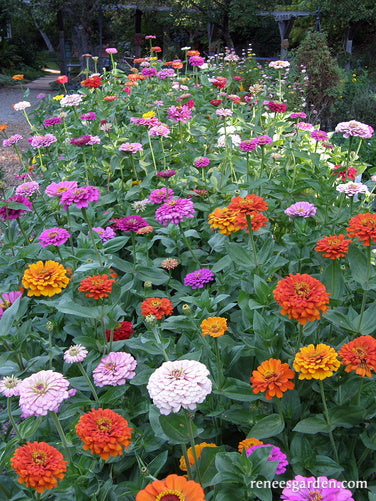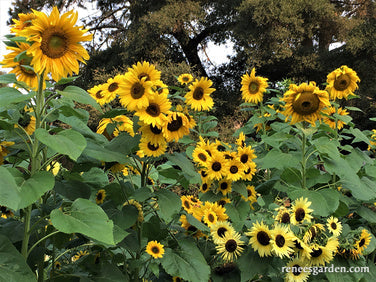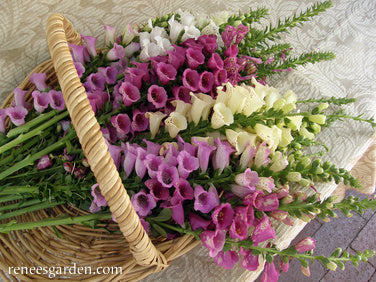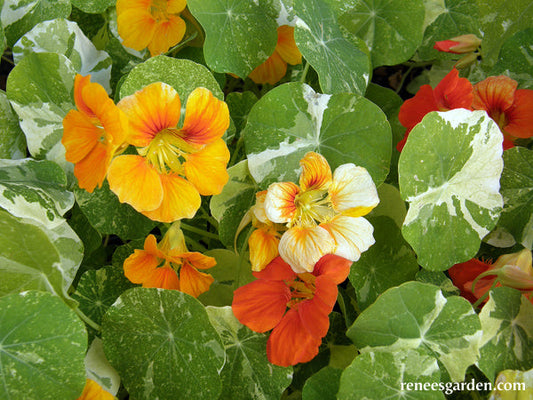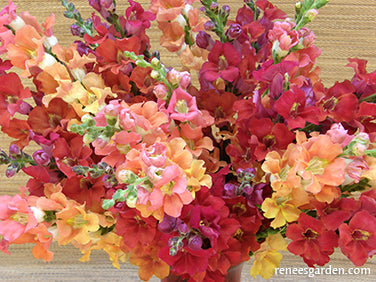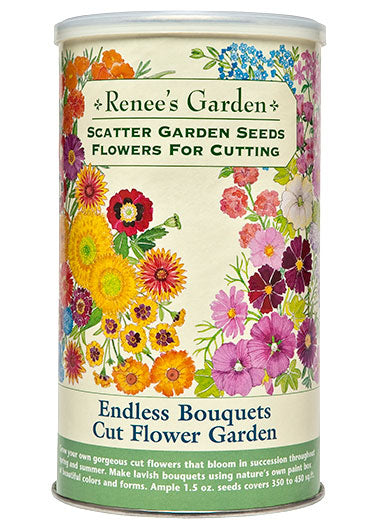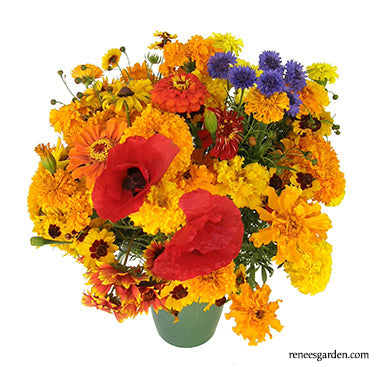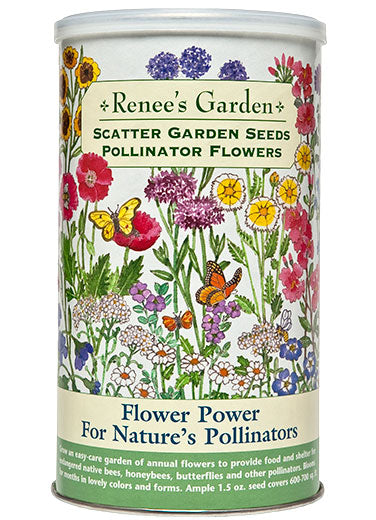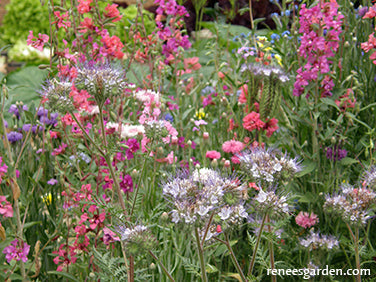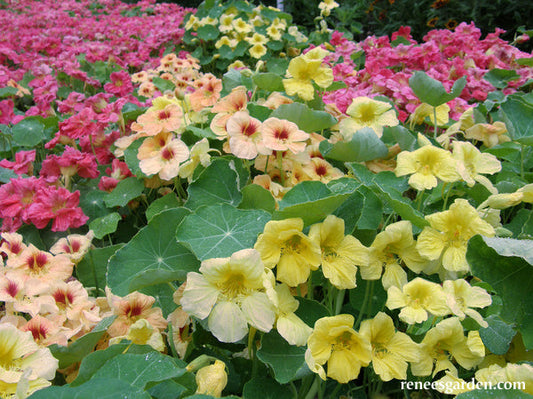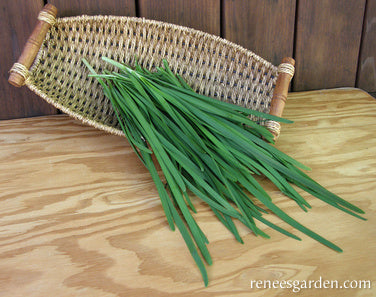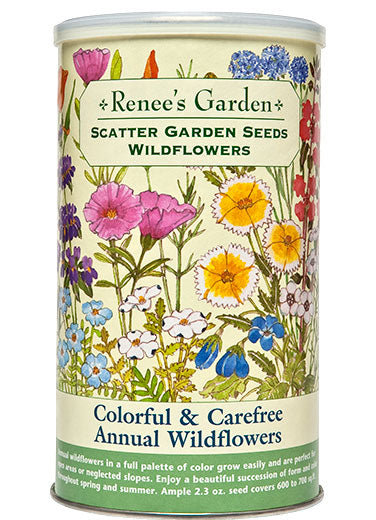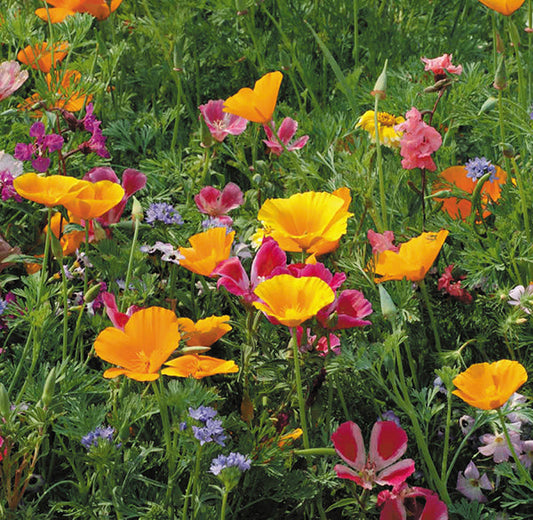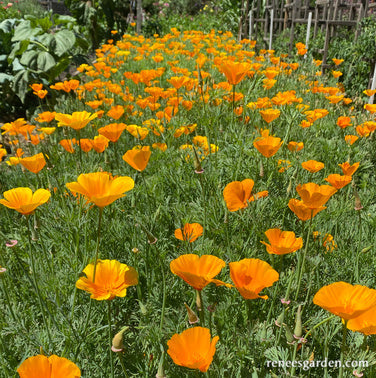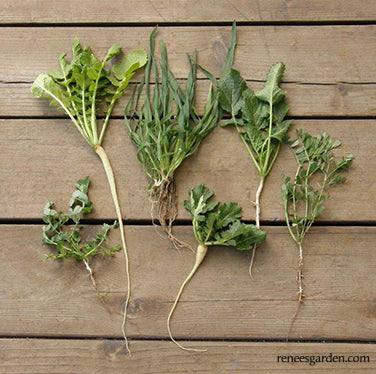Attracts Bees & Beneficials
Welcome Bee Friends and Others with Benefits
Plant these blooms to feed and nurture many kinds of beneficial insects from pollinators to pest control.
-
Butterfly Zinnias Summer Pinwheels
ANNUAL
Summer/fall bloom.
Frost tender.EASY TO START DIRECTLY IN THE GARDEN
Sow seeds in well-worked soil in full sun when danger of frost is past and weather is warm and above 50°F (10°C) both day and night. Space seeds 2 to 3 inches apart in rows 12 inches apart, cover about 1/2 inch deep and gently firm soil. Keep soil evenly moist while awaiting germination.
TO START EARLY INDOORS
Four weeks before last frost date, sow seeds 1/2 inch deep and 3 inches apart in a container of seed starting mix. Keep warm and moist and provide a strong light source until seedlings are ready to plant outside when temperatures rise above 50°F (10°C) day and night.
THIN OR TRANSPLANT
Space seedlings 8 to 12 inches apart when large enough to handle so plants have good air circulation and enough elbow room to grow and bloom freely.
GROWING NOTES
Zinnias can grow in ordinary garden soil in full sun. For large, abundant flowers, thin before seedlings get crowded. Adequate spacing and regular, even watering discourages mildew and keeps zinnias productive. Pick just as blossoms begin opening and petals are tight. Cut long stems well back into the plant to keep plants branching low and producing best blooms for summer long bouquets.
Regular price $3.39Sale price $3.39Unit price / per -
Dwarf Strawflower Rainbow Bouquet
ANNUAL
Summer/fall bloom
Can handle light frostSTARTING EARLY INDOORS
Start in spring 6 weeks before last expected frost. Sow seeds very thinly in a container of seed starting mix and cover very lightly. Keep evenly moist but not soggy, providing a strong light source. When seedlings are several inches tall, transplant 2 inches apart into a deeper containers. Once weather is settled and warm, acclimate to outdoor conditions before planting in the garden.
TO START EARLY OUTDOORS
Once all danger of frost is past, sow seeds 1 inch apart in containers of fresh potting mix, or broadcast thinly in fertile, well drained garden beds. Cover ¼ inch deep and keep evenly moist. When seedlings are several inches tall, thin to 6-8 inches apart so plants have room to branch and grow.
In Containers: Use containers 16-18 inches deep and wide filled with fresh potting soil. Sow seeds 1 inch apart, 1/4 inch deep. When several inches tall, thin or transplant seedlings 5 inches apart. Feed container plants monthly with all-purpose flower fertilizer.
GROWING NOTES
For fresh flowers, cut stems at desired length before the flower centers are fully open. To air dry for “everlastings,” simply remove leaves and hang upside down in bundles in a cool airy spot out of the sun. Dried Strawflowers cure quickly and last almost indefinitely.Regular price $3.69Sale price $3.69Unit price / per -
Heirloom Sweet Peas Mermaid's Dream
ANNUAL CLIMBING VINE
Spring/summer bloom
Frost tolerantEASIEST TO START OUTDOORS
Sweet peas must have well-drained soil, so dig deeply and enrich with aged manure or compost before sowing seeds. Erect a well-anchored trellis, vertical netting or other support for vines before planting. Sow seeds in full sun in cool early spring weather as early as the ground can be worked. In mild winter areas, where the ground does not freeze, seeds can be planted in fall to form strong root systems, then overwinter to bloom strongly in spring. Plant seeds 1 inch deep and 2 to 3 inches apart. When seedlings are 2 inches tall, thin them 4 to 5 inches apart, to allow plants room to mature.
GROWING NOTES
Sweet peas bloom best before the weather gets too hot, so if spring planting, sow as soon as ground can be worked. Where summer heat comes on fast, they’ll appreciate a spot with afternoon shade. Anchor supports well as vines will grow heavy with bloom. Protect seedlings from birds, slugs and snails. Mulch and keep well watered. For longest bloom, pick flowers often and keep faded blossoms cut.Regular price $3.69Sale price $3.69Unit price / per -
Pollinator & Songbird Sunflowers Paintbox Bouquet
ANNUAL
Summer/fall bloom
Frost tenderEASIEST TO PLANT OUTDOORS
Plant in full sun in good garden soil when weather is warm and settled, all danger of frost is past and both days and nights are evenly in the 50°F (10°C) range. Poke seeds into well-worked soil about 1/2 in. deep, 4 to 5 in. apart. Press soil firmly over seeds and keep moist until seedlings emerge in 8 to 10 days. Important: when seedlings are well-established, thin them to a final spacing of 1 foot apart so plants can grow sturdy stalks and big flowers. Extra seedlings can be transplanted easily.
TO START EARLY INDOORS
Several weeks before last frost date, sow seeds ½ inch deep in individual pots of well-drained seed starting mix. Keep moist and provide a strong light source until seedlings are well established and ready to plant outside. Transplant carefully, disturbing the roots as little as possible. Space seedlings 1 foot apart so plants will have room to grow and mature.
GROWING NOTES
Growing these colorful sunflowers for pollinators and bouquets is both easy and rewarding. Make several sowings several weeks apart to have a succession of flowers in full bloom. Keep soil moist and well weeded and protect very young seedlings from birds with netting or plastic berry baskets, removing before plants get crowded.
Regular price $4.89Sale price $4.89Unit price / per -
Pollinator Sunflowers Lemon Queen
ANNUAL
Summer/fall bloom
Frost tenderEASIEST TO DIRECTLY PLANT OUTDOORS
Plant in full sun in good garden soil only when weather is warm and settled, all danger of frost is past and both days and nights are evenly in the 50°F (10°C) range. Poke individual seeds into well-worked soil about 1/2 in. deep, 4 to 5 in. apart. Press the soil firmly over the seeds and keep the seedbed evenly moist until seedlings emerge in 8 to 10 days.
Important: when the seedlings are well-established, carefully thin them to a final spacing of 1 foot apart; this way they will have enough room to develop sturdy stalks that won’t blow over and big clusters of flowers. Any extra seedlings you remove can be transplanted elsewhere in the garden or potted up and given to friends.
GROWING NOTES
Growing these colorful sunflowers for pollinators and bouquets is both easy and rewarding. Make several sowings several weeks apart and you’ll have a succession of flowers in full bloom. Keep soil moist and well weeded and protect very young seedlings from birds with bird netting held tautly above the seedbed with supports, or use plastic berry baskets, removing baskets before plants get crowded.Regular price $3.39Sale price $3.39Unit price / per -
Giant Harvest Gourds Lunch Lady
BEST TO START SEEDS INDOORS
Several weeks before last spring frost date, sow 2 seeds each, 1 in. deep, in individual pots of potting mix. Keep warm and moist and provide a strong light source. When nights stay above 50°F (10°C), thin to one seedling per pot and gradually acclimate to outdoors. Transplant at along a sturdy fence or trellis to climb effortlessly and form a lush canopy or allow vines to ramble at garden edges.
START DIRECTLY OUTDOORS
Sow seeds directly outdoors only if you have a long growing season. Sow only after night temperatures stay solidly above 50°F. (10°C). In full sun, sow seeds 1 inch deep and 4 inches apart along a garden fence or sturdy trellis or along garden edges. Thin seedlings to final spacing 8 inches apart.
GROWING NOTES
Unique Lunch Lady gourds need full sun, rich soil and warm temperatures. For earliest and best yields, hand-pollinate gourds: pick a blooming male flower and dust pollen onto fresh female flowers (the ones with small fruits at the base).
Repeat as new flowers appear. Pollinated fruits start growing larger within several days. Gourds are mature when rinds are tough and the tendril next to the stem turns brown. Harvest with several inches of stem. Dry in a well-ventilated place.
Note: the flesh of Lunch Lady ornamental gourds has a bitter gene and is not edible.Regular price $4.69Sale price $4.69Unit price / per -
Fragrant Sweet Peas Raspberry Twirl
ANNUAL CLIMBING VINE
Spring/summer bloom
Frost tolerantEASIEST TO START OUTDOORS
Sweet peas must have well drained soil, so dig deeply and enrich with aged manure or compost before sowing seeds. Erect a well-anchored trellis, vertical netting or other support for vines before planting. Sow seeds in full sun in cool early spring weather as early as the ground can be worked.
In mild winters, where ground does not freeze, sweet peas can be planted in fall. Seedlings will form strong root systems, then overwinter to bloom vigorously in spring. Plant sweet pea seeds 1 inch deep and 2 to 3 inches apart. When seedlings are 2 inches tall, thin to 4-5 inches apart to allow plants room to mature.
GROWING NOTES
Sweet peas bloom best when they flower before the weather gets too hot, so if spring planting, sow as early as possible, especially in regions where summer heat comes on fast. Anchor climbing supports well as these vines will grow dense and heavy with bloom. Protect seedlings from birds, slugs and snails. Mulch and keep well watered for best flower production. For longest bloom, remove faded blossoms regularly.Regular price $3.99Sale price $3.99Unit price / per -
Heirloom Summer Garden Dancing, Joyous Sunflowers
NOTE
Seeds in this canister are packed with a larger quantity of organic rice hulls to help space them. Before opening, shake canister thoroughly to mix.
HOW TO PLANT AND GROW
When spring weather is warm and settled, and nights are reliably above 50°F (10°C), prepare the planting area by removing all weeds, grass, large clumps and stones. Loosen the top 2 inches of soil with a digging fork or shovel, then smooth with a flat rake.
Scatter mix thinly and evenly. Using your rake, work to cover the seeds with 1/2-1 inch of soil, then use planting mix or compost to cover any exposed seed mix. Water thoroughly with a gentle mist.
Keep weeded and watered; protect tiny seedlings from birds by using netting or ribbons of shiny, reflective flash tape at planting time. When 3-4 inches tall, remove covering and thin seedlings to 10-12 inches apart. This spacing is critical for sturdy, windproof plants with good root systems and large flowers.
HARVEST AND USE
For bouquets, cut when flowers just begin to open. Many diverse pollinators will busily visit the florets in each flower head and seeds will begin to mature. When the center disk florets have dried, birds will happily snack on ripening seed heads.
Harvest for winter feeding by covering ripening heads with paper bags until kernels are plump and hard shelled. Cut entire heads; store until cool and dry, then remove seeds. Store in closed containers to feed as needed.
Regular price $16.95Sale price $16.95Unit price / per -
Ornamental Edibles Bicolored Shiso
ANNUAL
Summer/fall harvest
Heat-loving, frost tenderTO PLANT DIRECTLY INTO THE GARDEN
When late spring weather has thoroughly warmed up, sow seeds 1 inch apart in well worked fertile soil in full sun. Cover 1/4 inch deep, firm soil and keep seedbed moist. Germination takes 1 to 2 weeks. After seedlings are well established, thin or transplant 8 inches apart to allow plants room to mature.
TO START EARLY INDOORS
Sow seeds 1 inch apart in a container of seed starting mix, 4 to 6 weeks before last expected frost. Keep warm and evenly moist, and provide a good light source. When seedlings are large enough to handle and night temperatures are solidly above 50°F (10°C ), acclimate gradually to outdoor conditions before planting in the garden 8 inches apart.
GROWING NOTES
Remember— it is critical to plant Shiso in the garden only after day and nights are solidly above 50°F (10°C). Pinch off growing tips when plants are 6 to 8 inches tall to encourage branching. Harvest sprays of leaves by cutting stems just above two new sprouting lateral branches to get lush regrowth.
NOTE: Can self-sow aggressively. Keep plants from spreading by cutting spent flowers so they don't drop seeds. Do not plant near natural areas.
Regular price $3.99Sale price $3.99Unit price / per -
Butterfly Flowers Spinning Wheels Marigolds
ANNUAL
Summer/fall bloom
Frost tenderTO PLANT OUTDOORS
Sow seeds directly into well-worked garden soil in full sun once all danger of frost is past. Space seeds several inches apart and cover about 1/4 inch deep. Keep soil evenly moist while awaiting germination in 7 to 10 days. When seedlings are well established, thin them to a final spacing of 8 to 10 inches apart so these vigorous plants have room to grow and bloom. Extra thinned seedlings can be transplanted easily.
TO START EARLY INDOORS
Sow seeds several inches apart in a container of well-drained seed starting mix 4 to 6 weeks before last expected frost date. Cover 1/4 inch deep, keep moist and provide a strong light source until ready to go outside. Transplant 8 to 10 inches apart once weather warms up after gradually acclimating seedlings to outdoor conditions.
GROWING NOTES
These cheerful marigolds are quick to bloom, carefree and non-fussy. Their profusion of long lasting flowers and handsome blue-green foliage is perfect in any sunny spot and makes long blooming handsome borders. Feed and water regularly. No need to pinch these self branching productive plants. Both butterflies and pollinators of all kinds are attracted to these flowers throughout the season.
Regular price $3.39Sale price $3.39Unit price / per -
Pollinator Dahlias Blazing Saddles
PERENNIAL GROWN AS ANNUAL
Frost tender
Summer/Fall BloomBEST TO START EARLY INDOORS
Sow seeds 2 inches apart in containers of seed starting mix, 4 to 6 weeks before last spring frost. Cover 1/2 inch deep, keep moist and warm and provide a strong light source until ready to plant outdoors. When weather is warm and settled, acclimate seedlings gradually to outdoor conditions. Plant 12-14 inches apart in full sun.
TO START DIRECTLY OUTDOORS
Wait until weather is warm and settled and night temperatures are above 50°F (10°C). Sow groups of 2 to 3 seeds 1/2 inch deep and 12-14 inches apart in well-worked, fertile soil in full sun. Cover lightly and keep soil moist but not soggy while awaiting germination. When well-established, thin carefully, leaving one single seedling per group, so plants have room to grow. Keep well-weeded and evenly watered.
GROWING NOTES
Encourage growth and plentiful flowers by feeding plants monthly. Remove faded flowers to prolong bloom. These dahlias will produce underground tubers after their first season of bloom.
In mild winter climates: tubers can overwinter in the ground.
In cold winter climates: dig up the tubers in late fall to replant next spring.Container Growing: Space seedlings 8 in. apart in containers at least 16-18 in. across and 16 in. tall.
Regular price $3.99Sale price $3.99Unit price / per -
Rainbow Plume Celosia Hippie Tie Dye
ANNUAL
Summer/fall color
Frost tenderBEST TO START EARLY INDOORS
Six weeks before last expected frost date, sow seeds 1 inch apart in a container of seed starting mix. Cover very lightly, no more than 1/8 inch. Keep warm and moist and provide a strong light source until seedlings are ready to plant out in the garden. Feed every 2 weeks with half-strength fertilizer.
Seedlings are ready to transplant when they are large enough to handle and night temperatures are evenly in the 50°F (10°C) range. Gradually acclimate seedlings to outdoor conditions, then plant in full sun 6 to 8 inches apart in rich, fertile soil.
TO START OUTDOORS
Sow seeds in a well-drained, finely textured seed bed in full sun when weather is warm and nights are above 50°F (10°C). Space seeds 2 to 3 inches apart and cover very lightly, then gently firm soil. Keep soil evenly moist while awaiting germination When seedlings are large enough to handle, thin or transplant 6-8 inches apart in full sun.
GROWING NOTES
Seedlings grow slowly at first, then vigorously by midsummer. Good drainage is essential. The dramatic plumes in their eye-catching color collage bloom hard and last all summer. Cut for colorful bouquets or hang bunches upside down inside to air dry as “everlasting” flowers.Regular price $4.99Sale price $4.99Unit price / per -
Heirloom Rainbow Flowers Colorful, Carefree Zinnias
NOTE
Seeds in this canister are packed with a larger quantity of organic rice hulls to help space them. Before opening, shake canister thoroughly to mix.
HOW TO PLANT AND GROW
When spring weather is warm and settled, and nights are reliably above 50°F (10°C), prepare planting area by removing all weeds, grass, stones and large clumps. Loosen the top 2 inches of soil with a digging fork or shovel, then smooth with a flat rake.
Scatter mix thinly and evenly. Using your rake, work to cover the seeds with 1/2 inch of soil, then use planting mix or compost to cover any exposed seed mix. Water thoroughly with a gentle mist.
Protect tiny seedlings from birds by using netting or ribbons of shiny, reflective flash tape at planting time. Keep weeded and watered; when 3 inches tall, remove covering and thin seedlings to 8-10 inches apart for good air circulation and enough elbow room to grow, branch and bloom freely.
HARVEST AND USE
For bouquets, pick just as flowers open, cutting long stems well back into the plant to keep them branching. Butterflies, bees, and other native pollinators will seek out and work these pretty flowers that provide them with nectar, pollen and shelter.
Zinnias are carefree and long-lasting, but will thrive and bloom longer with proper thinning, regular watering and several applications of organic fertilizer over their long flowering season.
Regular price $16.95Sale price $16.95Unit price / per -
Bonus Pack An Heirloom Sunflower Forest
ANNUAL
Spring/summer bloom
Frost tenderEASIEST TO PLANT OUTDOORS
Plant in full sun in good garden soil only when weather is warm and settled, all danger of frost is past and both days and nights are evenly in the 50°F (10°C) range. Poke individual seeds into well-worked soil about 1/2 in. deep, 4 to 5 in. apart. Press the soil firmly over the seeds and keep the seedbed evenly moist until seedlings emerge in 8 to 10 days.
Important: when the seedlings are well-established, carefully thin them to a final spacing of 1 foot apart; this way they will have enough room to develop sturdy stalks that won’t blow over and big clusters of flowers. Any extra seedlings you need to remove can be transplanted elsewhere in the garden or potted up and given to friends.
TO START EARLY INDOORS
Several weeks before last frost date, sow seeds 1/2 inch deep in individual pots of well-drained seed starting mix. Keep moist and provide a strong light source until seedlings are well established and ready to plant outside. Transplant carefully, disturbing the roots as little as possible. Space seedlings 1 foot apart so plants will have room to grow and mature.
GROWING NOTES
Growing these colorful sunflowers for pollinators and bouquets is both easy and rewarding. Make several sowings several weeks apart and you’ll have a succession of flowers in full bloom. Keep soil moist and well weeded. Protect very young seedlings from bird predation by covering the bed with bird netting held tautly well above seedlings by supports. Or use plastic berry baskets, removing before plants get crowded.
Regular price $8.99Sale price $8.99Unit price / per -
Hummingbird Foxgloves Carousel Mix
PERENNIAL
Late Spring/Summer bloom
Frost hardy USDA zones 4–9
START EARLY INDOORSSow seeds as thinly as possible in a container of seed starting mix. Cover 1⁄8 inch deep with mix, keep moist and between 60-70°F (16-21°C). Provide a strong light source until ready to plant into the garden.
Feed every 2 weeks with half-strength fertilizer. Once seedlings are large enough to handle, transplant 2 to 3 inches apart into individual pots. When plants are 3 to 4 inches tall, gradually acclimate to outdoor conditions and plant out in well-drained soil. Can also be planted in early/mid summer for bloom the following spring.
THIN OR TRANSPLANT
Space seedlings 12-15 inches apart so the plants have enough elbow room.
GROWING NOTES
Deer resistant foxgloves do well in light shade, dappled sunlight all day or full morning sun. They appreciate rich fertile soil and consistent moisture. In mild summer areas, they can handle full sun all day. Cut the softly colored spires of bloom often for lavish bouquets.
Encourage repeat bloom and flowering side shoots by cutting spent flower stalks at plant bases. Plants also self sow readily. A favorite of hummingbirds, butterflies and bumblebees!
Caution: Toxic if eaten.
Regular price $3.39Sale price $3.39Unit price / per -
Heirloom Nasturtiums Alaska Mix
ANNUAL
Spring/summer/fall bloom
Frost tenderEASY TO START OUTDOORS
Sow seeds in spring once all danger of frost is over in full sun (or part shade in hot climates). Nasturtiums need no added fertilizer in most soils. Poke seeds into well-worked soil about 1 inch deep and 3 to 4 inches apart. Press soil firmly over the seeds and keep moist. When seedlings are large enough to handle, thin to 10 inches apart as mounding plants need ample room.
TO START EARLY INDOORS
Sow 2 seeds each in individual 4 inch pots of well-drained seed starting mix 3 weeks before last expected frost date. Cover 1 inch deep. Provide a strong light source. When seedlings have several sets of leaves pinch out the weaker seedling, leaving 1 per pot. When night temperatures reach 50ºF (10ºC), gradually acclimate to outdoors. Transplant seedlings into the garden 10 inches apart in full sun.
GROWING NOTES
These old-fashioned nasturtiums with handsome variegated leaves are easy to grow in any well-drained soil. Alaska’s softly mounding foliage and bright flowers will quickly fill garden beds and make a showy accent in planters or patio pots. Thinned to proper 10 inch spacing, they are a perfect disguise to cover fading bulb foliage in late spring.
Regular price $3.69Sale price $3.69Unit price / per -
Butterfly Snapdragons Chantilly Summer Flame
HARDY ANNUAL
Spring/Summer/Fall bloom.
Can handle light frostSTART SEEDS INDOORS
Start seeds indoors in a container of seed starting mix in early spring 6 to 8 weeks before the last expected frost. Dampen soil mix evenly before sowing. Sow seeds 1 inch apart, covering only with a fine dusting of mix. Keep evenly moist but not soggy and provide a strong light source until ready to plant outdoors. When seedlings have several sets of leaves, transplant them 2 inches apart into a deeper container. After they reach 2 to 3 inches tall, gradually acclimate sturdy, well-established seedlings to outdoor conditions before transplanting in full sun.
THIN OR TRANSPLANT
Space seedlings 10 to 12 inches apart for best performance.
GROWING NOTES
Heat and wind-resistant Chantilly adds height, color and texture to garden beds and provides abundant gorgeous summer bouquets. Feed and water well and keep spent flower stalks cut off for longest bloom season. Cut stalks when 8-10 blossoms are open; do not crowd in the vase for best, longest lasting cut flowers. In mild climates, snapdragons can also be planted in late fall to overwinter and bloom as a spring flower.
Regular price $4.99Sale price $4.99Unit price / per -
Endless Bouquets Cut Flower Garden
NOTE
The seed mix is packed with a larger quantity of organic rice hulls to help space the tiny seeds. Before opening, shake canister thoroughly to mix them together.
HOW TO PLANT
As soon as ground can be worked in early spring, sow mix in ordinary garden soil in full sun. In mild climates, where the ground does not freeze hard in winter, seeds can also be planted in late fall to over-winter and bloom the next spring.
Prepare the planting area by removing all weeds, grass and large stones. Break up soil clumps and evenly loosen the top 2 inches of soil with a digging fork or shovel, then smooth out with a flat rake.
Shake can thoroughly, then scatter the contents thinly and evenly over prepared ground. Using your rake, lightly cover the seed mixture, about ¼ inch deep, and then lightly firm the soil. Water evenly with a gentle mist. Keep bed moist while awaiting germination and when the seedlings are small.
GROWING NOTES
Harvesting opening flowers regularly for bouquets will help to encourage repeat bloom. Plants will flower in succession and bloom much longer if watered regularly. At season’s end, allow spent flowers to form pods and then drop their seeds to bloom again next spring.
ANNUAL CUTTING FLOWER MIX
NAME MIX% TYPE HEIGHT COLOR Aster
(Callistephus chinensis)2 A 12 - 36" Blue/Pink/White/Purple Calendula
(Calendula officinalis)10 A 12 - 24" Yellow/Orange/Cream Bachelor Buttons
(Centaurea cyanus)8 A 12 - 36"
Blue/RoseWhite Godetia
(Clarkia amoena)2 A 10 - 18" Pink/White Clarkia
(Clarkia elegans)3 A 10 - 18" Pink/Lavender Plains Coreopsis
(Coreopsis tinctoria)3 A 12 - 36" Yellow-Maroon Cosmos
(Cosmos bipinnatus)7 A 36 - 60" White/Pink/Crimson/Rose Chinese Forget-Me-Not
(Cynoglossum amabile)10 A/B 18 - 24" Blue Larkspur
(Delphinium ajacis)3 A 12 - 36" White/Pink/Blue/Violet African Daisy
(Dimorphotheca aurantiaca)5 A 10 - 16" Orange/Salmon/White Poppy
(Eschscholzia californica)2 TP 12 - 18" Yellow/Orange Annual Gaillardia
(Gaillardia pulchella)2 A 12 - 24" Yellow-Red Baby's Breath
(Gypsophila elegans)8 A 8 - 18" White Sunflower
(Helianthus annus)
2 A 24 - 72" Yellow Strawflower
(Helichrysum monstrosum)
1 A 24 - 36" Yellow/White/Red/Pink Candytuft
(Iberis umbellata)
5 A 12 - 18" White/Pink/Violet Lavatera (Tree Mallow)
(Lavatera trimestris)2 A 24 - 48" White/Pink Alyssum Tall (Sweet Alyssum)
(Lobularia maritima)
5 TP 8 - 16" White Evening Primrose
(Oenothera lamarckiana)
1 B/P 24 - 60" Yellow Shirley Poppy
(Papaver rhoeas)
3 A 12 - 30" White/Pink/Red California Bluebells
(Phacelia campanularia)
1 A 8 - 20" Blue Black Eyed Susan
(Rudbeckia hirta)
5 A/B/P 12 - 36" Yellow Catchfly
(Silene armeria)
2 A/B 16 - 22" Pink Marigold
(Tagetes erecta)
3 A 12 - 16" Yellow/Orange/Maroon Zinnias
(Zinnia elegans)
5 A 12 - 36" White/Purple/Yellow/Orange/Red
Inert Material: Organic rice hulls
A = Annual B = Biennial TP = Tender PerennialRegular price $16.95Sale price $16.95Unit price / per -
Flower Power For Nature's Pollinators
NOTE
The seed mix is packed with a larger quantity of organic rice hulls to help space the tiny seeds. Before opening, shake canister thoroughly to mix them together.
HOW TO PLANT
As soon as ground can be worked in early spring, sow mix in ordinary garden soil in full sun. In mild climates, where the ground does not freeze hard in winter, seeds can also be planted in late fall to overwinter and bloom the next spring.
Prepare the planting area by removing all weeds, grass and large stones. Break up soil clumps and evenly loosen the top 2 inches of soil with a digging fork or shovel, then smooth out with a flat rake.
Shake the can thoroughly, then scatter the contents thinly and evenly over the prepared ground. Using your rake, lightly cover the seed mixture, about 1/4 inch deep, and then lightly firm the soil. Water thoroughly and evenly with a gentle mist. Keep soil bed evenly moist while awaiting germination and when the seedlings are small. Water regularly for best blossoms.
GROWING NOTES
Plants will flower in succession and bloom much longer if watered regularly. At season’s end, allow spent flowers to form pods and then drop their seeds to bloom again next spring.
ANNUAL POLLINATOR FLOWER MIX
INDIVIDUAL VARIETY NAMESMIX% Chinese Forget-Me-Not19.6Baby Blue Eyes19.6 Single Chinese Aster9.8 Cornflower, ‘Polka Dot Mix’9.8Shirley Poppy
7.8 Sweet Mignonette
7 Tidy Tips
4.9 Virginia Stock10 Creeping Daisy3 Clarkia3 Globe Gilia2.9 Lemon Mint2 California Bluebell2 Lacy Phacelia1.5 Tall White Alyssum1 Plains Coreopsis1 Inert Material: Organic rice hulls Regular price $16.95Sale price $16.95Unit price / per -
Hummingbird Nasturtiums Aloha Mix
ANNUAL
Spring/Summer/Fall bloom
Frost tenderEASY TO START OUTDOORS
In spring, when danger of frost is past, sow seeds in a sunny spot (or part shade in hot climates). Nasturtiums need no added fertilizer in most soils. Poke seeds into well-worked soil about 1 inch deep and 5 inches apart. Press soil firmly over the seeds and keep moist. When seedlings are large enough to handle, thin to 10 inches apart as mounding plants need ample room to grow.
TO START EARLY INDOORS
Sow 2 seeds each in individual 4 inch pots of well-drained seed starting mix 3 weeks before last expected frost date. Cover 1 inch deep. Provide a strong light source. When seedlings have several sets of leaves, pinch out the weaker seedling, leaving 1 per pot. When weather is evenly in the 50°F (10°C) range, gradually acclimate to outdoor conditions. Transplant seedlings into the garden 10 inches apart in full sun.
GROWING NOTES
These mounding nasturtiums are reliable and easy to tuck into any well-drained spot. They are a perfect disguise to cover fading bulb foliage in late spring. Their softly draping leaves and sunny flowers will quickly fill garden beds or containers. Hummingbirds come readily to drink the blossom’s nectar. Leaves and flowers are tasty additions to salads and sandwiches.
Regular price $3.99Sale price $3.99Unit price / per -
Heirloom Herbs Garlic Chives
PERENNIAL
Spring/summer/fall harvest
Frost hardyTO PLANT DIRECTLY OUTDOORS
In the cool weather of early spring, sow clusters of 7 to 10 seeds 8 to 10 inches apart in well-worked, fertile soil in sun or part shade. Cover 1/4 inch deep and press soil firmly over seeds. Keep evenly moist as seeds germinate slowly over several weeks. Emerging seedlings have slender, straight leaves.
TO START EARLY INDOORS
In early spring, sow seed thinly in a container of seed starting mix and cover 1/2 Inch deep. Keep evenly moist as seedlings slowly emerge and provide a good light source. Gradually acclimate to outdoor conditions before transplanting clusters of 7 to 10 seedlings, planting each cluster 8 inches apart.
GROWING NOTES
Garlic chives grow slowly at first, but soon mature into sturdy bright green mounds crowned with pretty white edible blossoms. After bloom finishes, shear entire plant back to 4 inches to encourage regrowth of tender new leaves. These hardy, self-sufficient plants are attractive additions to the flower or herb garden.Regular price $4.89Sale price $4.89Unit price / per -
Colorful & Carefree Annual Wildflowers
NOTE
Seeds are packed with a larger quantity of milled rice hulls to help space the tiny seeds when scattering. Before opening, shake the can thoroughly to mix them together so when you cast the seeds they are spaced with room for the plants to grow.
HOW TO PLANT
As soon as the ground can be worked in early spring, plant the seeds in ordinary garden soil in full sun. In mild climates, where the ground does not freeze hard in winter, seeds can also be planted in late fall to overwinter and bloom the next spring.
To prepare the planting area: remove all weeds, grass and large stones. Break up soil clumps and evenly loosen the top 2 inches of soil with a digging fork or shovel, then smooth out with a flat rake.
Shake the can thoroughly before opening, then scatter the contents thinly and evenly over the prepared ground. Using your rake, cover the seed mixture 1/4 inch deep and lightly firm the soil. Water with a gentle mist thoroughly and evenly. Keep the soil moist while awaiting germination and while the seedlings are small.
GROWING NOTES
When wildflower plants are mature they can handle somewhat dry conditions, but will thrive and bloom much longer if watered regularly. For indoor bouquets, cut the flowers as blossoms open. At season’s end, let spent flowers form pods and drop seeds to bloom again the next spring.
WILDFLOWER MIX
INDIVIDUAL VARIETY NAMES MIX% Candytuft
Iberis umbellata18 Baby Blue Eyes
Nemophila menziesii
16 Five Spot
Nemophila maculata
16 Chinese Houses
Collinsia heterophylla12 African Daisy
Dimorphotheca aurantiaca8 CA Poppy
Eschscholzia californica7 CA Bluebell
Phacelia campanularia5 Shirley Poppy
Papaver rhoeas5 Bird’s Eyes
Gilia tricolor4 Dwarf Godetia
Clarkia amoena2 Clarkia
Clarkia unguiculata2 Globe Gilia
Gilia capitata2 Tidy Tips
Layia platyglossa2 Inert Material: Clean milled rice hulls NOTE
The seed mix is packed with a larger quantity of organic rice hulls to help space the tiny seeds. Before opening, shake canister thoroughly to mix them together.
Regular price $16.95Sale price $16.95Unit price / per -
California Native Orange Poppies
NOTE
The Poppy seeds in this can are packed with a larger quantity of milled rice hulls to help space the tiny seeds when scattering.
Before opening, shake the can thoroughly to mix them together so when you cast the seeds they are spaced with room for the plants to grow.
HOW TO PLANT
In mild winter climates, where the ground does not freeze hard, poppies can be sown in late fall to overwinter for spring bloom. Or, plant as early as possible in spring, as poppies can handle light frosts and bloom longest when given a good start in cool weather.
To prepare the planting area: remove all weeds, grass and large stones. Break up soil clumps and evenly loosen the top 2 inches of soil with a digging fork or shovel, then smooth out with a flat rake.
Shake the can thoroughly before opening, then scatter the contents thinly and evenly over the prepared ground. Using your rake, cover the seed mixture 1/4 inch deep and lightly firm the soil. Water with a gentle mist thoroughly and evenly. Keep the soil moist while awaiting germination and while the seedlings are small.
GROWING NOTES
Mature poppy plants can handle dry conditions, but will thrive and bloom much longer if watered regularly. Poppies make lovely cut flowers if brought indoors just as the buds begin to open. At season’s end, let spent flowers form pods and drop seeds to bloom again the next spring.
Regular price $16.95Sale price $16.95Unit price / per -
Protect & Fertilize Green Cover Crop Blend
The Renee’s Garden Cover Crop Mix is a blend of several legumes, grass, roots, and rapeseed. The legumes, Austrian Winter Peas, Fava beans and Hairy Vetch all fix nitrogen from air into their root nodules, loosen and aerate dense soil and gather deep nutrients and minerals. Winter Rye Grass has thick roots which hold the soil to prevent erosion and takes up excess nutrients in the soil. Rapeseed takes up large amounts of nutrients that would otherwise be leached out of the soil by the winter rains. When these cover crop plants are incorporated back into the soil in the spring, they break down releasing the nutrients and minerals back into the soil and add plenty of organic matter which improves the soil structure.
NOTE
Seed is packed with a larger quantity of organic rice hulls to help space seeds. Before opening, shake can thoroughly to mix together.
FORMULA MIX
Winter Rye, Hairy Vetch, Fava Bean, Rapeseed and Austrian Winter Peas.
Inert material: organic rice hulls.
WHEN TO PLANT
In Mild Winter Climates, where ground does not freeze hard, sow in late fall to over-winter for spring growth.
In Cold Winter Climates, where ground freezes hard, plant in fall for winter die back and then incorporate in spring, OR sow as early as possible in spring..
HOW TO PLANT AND GROW
Remove all weeds, grass and large stones from the planting area and break up soil clumps. Evenly loosen the top 2 inches of soil with a rake. Shake the can thoroughly before opening, then scatter contents evenly over the prepared ground, aiming for scattering the seeds 1 to 2 inches apart. Use a rake to cover the seed mixture with fine soil 1/4 to 1/2 inch deep. Lightly firm soil with the back of the rake and water thoroughly. Keep soil bed evenly moist while awaiting germination and while seedlings are small. Plants will grow and thrive best if watered regularly.
INCORPORATING YOUR COVER CROP
Method 1: When 5 to 6 inches tall, use a garden fork, shovel or rototiller to turn the cover crop into the ground to break down and enrich soil for planting. The breakdown process takes about a month.
Method 2: When cover crop is 1 foot tall, pull out the plants, shake off soil and then compost the plant material to incorporate it into the soil later, when it has turned into rich, finished compost. Timing depends how long your composting process takes.
Method 3: When cover crop reaches 1 to 1-1/2 feet tall, weed whack to chop it down. Cover the chopped material with black plastic to hasten decomposition, then turn the nutritious residue into the soil 2 to 3 weeks before sowing your garden crops.
Regular price $16.95Sale price $16.95Unit price / per

